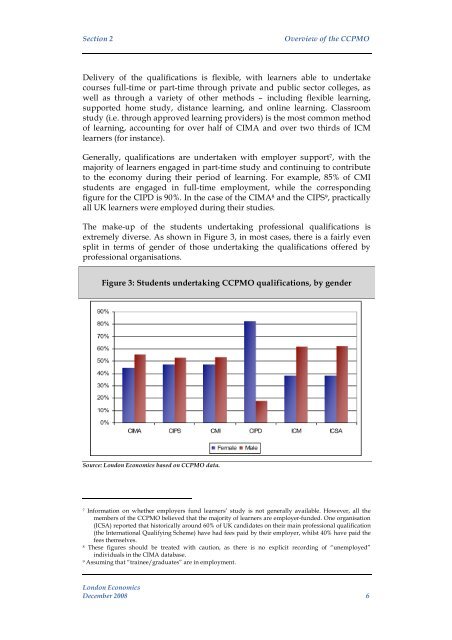Economic impact assessment of the CCPMO: Final report - CIPD
Economic impact assessment of the CCPMO: Final report - CIPD
Economic impact assessment of the CCPMO: Final report - CIPD
You also want an ePaper? Increase the reach of your titles
YUMPU automatically turns print PDFs into web optimized ePapers that Google loves.
Section 2<br />
Overview <strong>of</strong> <strong>the</strong> <strong>CCPMO</strong><br />
Delivery <strong>of</strong> <strong>the</strong> qualifications is flexible, with learners able to undertake<br />
courses full-time or part-time through private and public sector colleges, as<br />
well as through a variety <strong>of</strong> o<strong>the</strong>r methods – including flexible learning,<br />
supported home study, distance learning, and online learning. Classroom<br />
study (i.e. through approved learning providers) is <strong>the</strong> most common method<br />
<strong>of</strong> learning, accounting for over half <strong>of</strong> CIMA and over two thirds <strong>of</strong> ICM<br />
learners (for instance).<br />
Generally, qualifications are undertaken with employer support 7 , with <strong>the</strong><br />
majority <strong>of</strong> learners engaged in part-time study and continuing to contribute<br />
to <strong>the</strong> economy during <strong>the</strong>ir period <strong>of</strong> learning. For example, 85% <strong>of</strong> CMI<br />
students are engaged in full-time employment, while <strong>the</strong> corresponding<br />
figure for <strong>the</strong> <strong>CIPD</strong> is 90%. In <strong>the</strong> case <strong>of</strong> <strong>the</strong> CIMA 8 and <strong>the</strong> CIPS 9 , practically<br />
all UK learners were employed during <strong>the</strong>ir studies.<br />
The make-up <strong>of</strong> <strong>the</strong> students undertaking pr<strong>of</strong>essional qualifications is<br />
extremely diverse. As shown in Figure 3, in most cases, <strong>the</strong>re is a fairly even<br />
split in terms <strong>of</strong> gender <strong>of</strong> those undertaking <strong>the</strong> qualifications <strong>of</strong>fered by<br />
pr<strong>of</strong>essional organisations.<br />
Figure 3: Students undertaking <strong>CCPMO</strong> qualifications, by gender<br />
Source: London <strong>Economic</strong>s based on <strong>CCPMO</strong> data.<br />
7 Information on whe<strong>the</strong>r employers fund learners’ study is not generally available. However, all <strong>the</strong><br />
members <strong>of</strong> <strong>the</strong> <strong>CCPMO</strong> believed that <strong>the</strong> majority <strong>of</strong> learners are employer-funded. One organisation<br />
(ICSA) <strong>report</strong>ed that historically around 60% <strong>of</strong> UK candidates on <strong>the</strong>ir main pr<strong>of</strong>essional qualification<br />
(<strong>the</strong> International Qualifying Scheme) have had fees paid by <strong>the</strong>ir employer, whilst 40% have paid <strong>the</strong><br />
fees <strong>the</strong>mselves.<br />
8 These figures should be treated with caution, as <strong>the</strong>re is no explicit recording <strong>of</strong> “unemployed”<br />
individuals in <strong>the</strong> CIMA database.<br />
9 Assuming that “trainee/graduates” are in employment.<br />
London <strong>Economic</strong>s<br />
December 2008 6

















